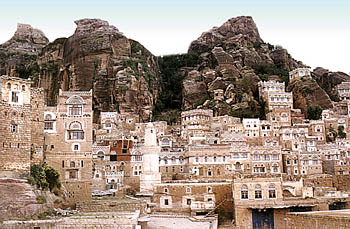
Al-Tawilah Fortresses [Archives:2000/49/Last Page]
December 4 2000
Al-Tawilah lies in an area north-west of Sanaa. It is two thousand meters above the sea level. Many well-known personalities, judges, scientists and men of letters, like Saleh Bin Mehadi Al-Muqbli author of Al-Ilm Al-Shamikh, come from area.
Al-Tawilah is connected with Maswar, Al-Masanih, Thula, Wallaa in the north, and Hamadan and Sanaa in the east, Al-

Geologically, volcanic layers cover the mountain grooves that spread towards bani Al-Khayat passing through the city center to al-Mahweet in the West.
Historically, Al-Tawilah was used to be a bridge for the Ottoman invaders under leadership of Sinan Pasha who had crossed in the 15th century. His soldiers were stationed in citadels.
There are five giant mountains atop which citadels and fortresses had been built throughout historical periods. Unlike military fortresses and citadels no domes are found here. However, they do not seem to be less defensive than those military ones. Military fortifications had been erected nearby tops of these semi-coned mountain peaks. Many military catering units were also built there. This raises the curiosity and interest of tourists regarding the origin of such fortifications and the nature of their defensive and security role in the town and the surroundings. Many real and imaginary stories have been narrated in regard to the five citadels and fortresses highlighting their characteristics as defensive tools.
Natives proudly speak about Al-Qarani fortress situated to the East of the town, Thihyan, Shamsan and the titanic Al-Manqar fortresses to the West. In addition, there are the Hajar Al-Sayed and Al-Tawilah fortresses.
Each citadel and fortress played a particular role in security, keeping food and maintaining tools. The dome of Al-Tawilah fortress contains a water spring that used to meet the needs of the all fortresses. The Hajar Al-Sayid fortress was capped by a big Ottoman canon that nobody knew how the Ottomans carried in spite of very narrow way that one can hardly walk in.
It is not easy to recognize these particulars when the visitor is amazed at general frame of the traditional architecture that looks alike at the first sight. About 19 km away from Al-Tawilah lies Shibam, another archeological tourist site. You can see an archeological residential building called Al-Kheir fortress on a volcanic mountain. It is a polygon mountain center as a concave-triangle that is surrounded by residential buildings whose background constitutes the defensive and protection line that could hardly be broken through, by the only gate situated to the east. It is a sample of the residential historic buildings that used to protect people from foreign invasions.
——
[archive-e:49-v:2000-y:2000-d:2000-12-04-p:./2000/iss49/lastpage.htm]


